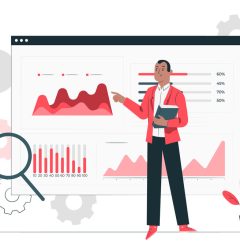Our first conversation was with Murali Aiyer, a Social Entrepreneur and co-founder of “SALTLABS”, Leadership Coach to Leading corporates and former Director HR of CRISIL Limited (a Standard & Poor’s Company)
Here’s what Murali shared with PossibleWorks when he was asked to speak on the Evolution of people/talent management practices. We also asked him to specifically address the following questions.
Q – Hello Murali! Welcome to today’s discussion on a topic that is close to your heart. In your long career, you have had the opportunity to not just watch but also shape how organizations manage their talent and their performances. In your experience, how effective are performance reviews in today’s context, and what, in your opinion, needs to change about them?
In other words, you are asking if companies can jettison traditional year-end evaluations? In a McKinsey Quarterly (May 16, 2016) article, Boris Ewenstein, Bryan Hancock, and Asmus Komm talk of how performance reviews epitomize the absurdities of corporate life. That article truly reflects my opinion of performance management reviews from an employee’s perspective. However, they are silent on other perspectives of strategy, process, innovation, etc.
“Performance Management System is a strategy tool and not just an HR tool”
To elaborate, that blog post talks of how performance management processes were frustrating, de-motivating, and negatively affected employee engagement. In 2017, we saw companies like Microsoft, GE, and Deloitte moving to agile systems, with continual feedback and coaching. It’s high time employers adopted a culture of ongoing assessment and pursued performance acceleration along with a performance review.Q – What do you think made these companies adopt a continuous assessment and feedback process?
The McKinsey article highlights the demotivating nature of industrial-era performance reviews and their ‘stack and rank’ approach. The authors look at the structure behind the ‘rethink performance’ approach and break the patterns of change down into 4 elements, as described below.
- Rethink employee performance to bring the focus specifically on individuals who are a step function away from average—at either the high or low end of the performance—rather than trying to differentiate among the bulk of employees in the middle.
- Collect more objective performance data through systems that automate real-time analyses.
- De-link performance data and compensation planning, except at the high or low end of the performance.
- Use better data to bring in a shift in emphasis from backward-looking evaluations to frequent, fact-based performance and development discussions.
Q – What are the key elements of a PMS that you believe are critical for an organization?
When you look at a ‘Performance Management System today, you look at the HR leaders. You see how the HR leaders handle just one component of the entire system, while the system reflects the performance culture of the entire organization’.
“Performance Management needs to be driven by the highest level of the organization”
The system is hopefully considered relevant to trigger off 4 different conversations:
- What is our work, how do we look at our goals, what are these goals and how are we outlining the relevant pieces in our goals?
- How are we doing? Are we monitoring, tracking, and getting perspectives? Are we getting inputs /data to measure the performance?
- How can we improve? The answer to this question has different connotations to an organization. What does it need to do in terms of set up, team, culture, locations, growth plans, individuals? What capabilities need to be built if we are to be ready for the next level including the innovation perspective.
- What will this mean for our teams? This should be about consequence management in terms of how people look at the performance.
Q – Who according to you are the key drivers of performance management in an organization?
‘The organization in its entirety needs to be a part of this function. It cannot be considered to be solely an HR-driven function’.
Performance Management will not take off if it is made an HR only function. It has to trigger important 4 questions.
- How do we implement our strategy?
Ans: By converting organizational strategy into goals.
- How are we Measuring and monitoring?
Ans: By tracking and getting in the data, providing and acting on the feedback.
- How we can improve?
Ans: This is all about employee development, providing them the right skills and tools.
- What are we doing for our teams?
Ans: This should be provided through Rewards and Recognition and consequence management.
Unfortunately, these conversations are not well understood. That’s where the challenge is, especially in organizations that fail to get the most out of their PMS systems.
Q – Do you believe a Performance Management System should really address these 4 elements that you just described?
Yes, the Performance Management System has to address all 4 elements. The organization needs to have a culture that enables these four things to be addressed. Otherwise, even with the best possible PMS systems, organizations will have no clue on how to operate them and employ them effectively. This is why you see excellent systems not yielding the right results.
Q – How can a PMS bring in performance-based meritocracy and objective employee assessment within an organization?
This is a broad question that gets decided by the culture of the organization. Let me share with you a personal experience. In one of my previous organizations, one of the tasks we had to do was how to bring in a performance-based meritocracy. The task needed us to relook at who we are as an organization and we needed to define our organization’s business. It was not easy even for an established company like ours. It required us to bring in an external consultant to bring in an outsider’s perspective.
“Organizational culture defines how much benefit it can derive from performance management system”
The biggest danger of adopting a performance management system is that we try to get into measuring those parameters that are easy to measure. Instead of the parameters that are relevant to measure. As a result, sometimes you can end up with the laundry list. Once that framework gets finalized, then we sit down with the CEO, to have them articulate their goals and objectives and get them ratified by the Board of Directors. Then it needs to cascade down. Everyone’s job is to ensure that the CEO meets his/her goals. That’s what they need to do – based on the framework that is provided. That’s how it gets cascaded under probably three or four or five levels and in those 4 or 5 levels, everyone does things so that their leader can achieve the goals that are set. At the apex level, that gets measured by the Board. If you have that kind of a structure, it is very critical the CEO needs to first freeze his own goals before he comes across and sets the goals for everyone else. In 95% of organizations, this doesn’t happen. They’ll expect the goals to come from bottom-up or start somewhere in between and meander along. This is decided by the culture of the organization. It needs this discipline. In today’s world, this is even more relevant. Earlier we could manage with an annual goal, and but revised it quarterly. Today, taking a quarterly view as the first step is the way to go forward. With technology and the ability to collect data and make those tweaks, I think it makes a lot of sense. Where organizations go wrong is in the discipline that is required to get the strategy right. And, if you look at it, a ‘performance management system is a strategic tool and not just an HR tool’.



